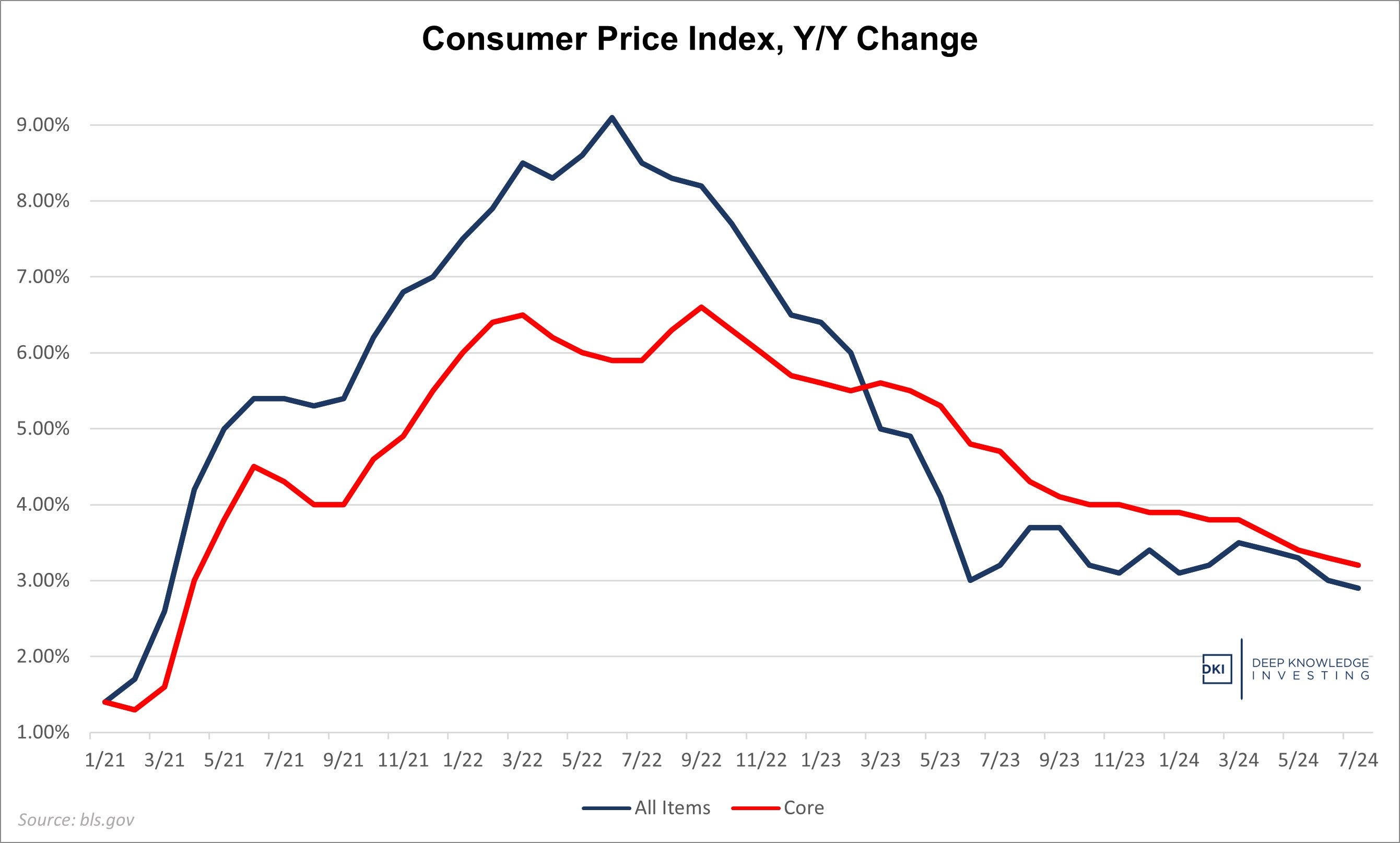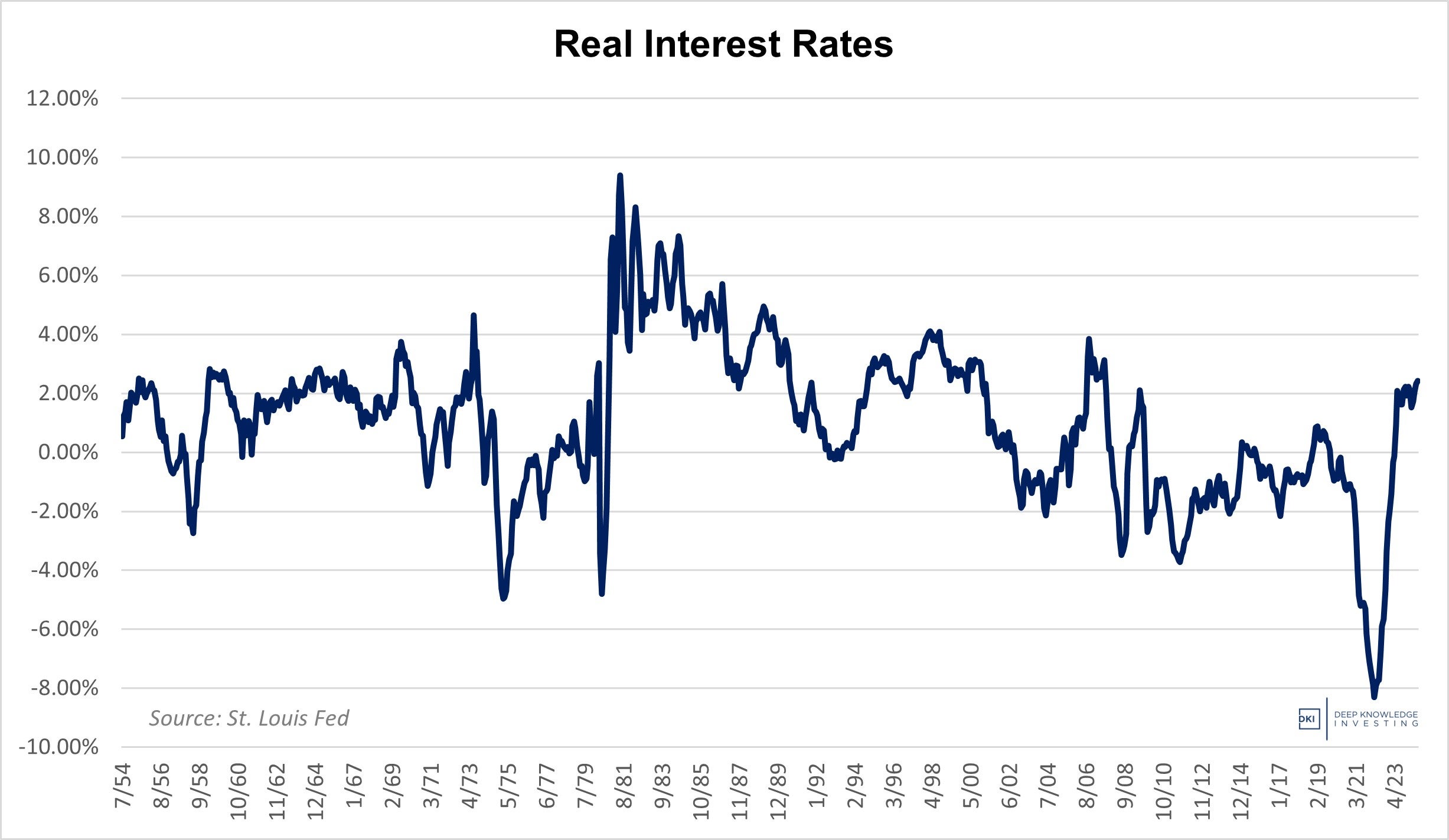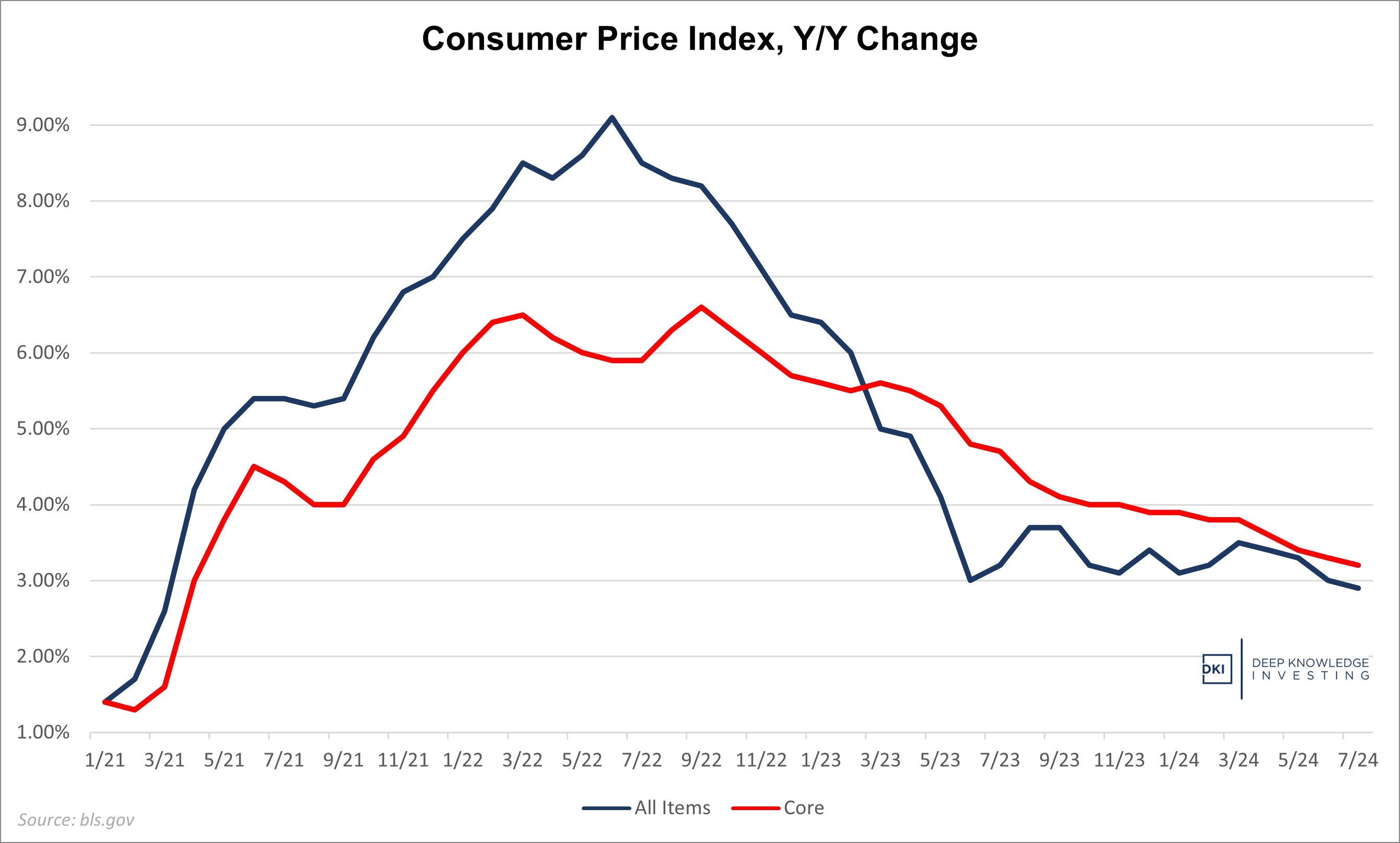Today, we got the July Consumer Price Index (CPI) report which showed an overall increase of 2.9% for the last year and 0.2% for the month. That’s below last month’s 3.0% and expectations of 3.0%. The 0.2% monthly increase was in line with the 0.2% expected, and a bigger increase vs last month’s -0.1%. The Core CPI which excludes food and energy was up 3.2% vs last year and up 0.2% from last month. Both of those were consistent with expectations. The annual number is still well above the Fed’s 2.0% target although there is a clear trend in recent months toward disinflation. (Disinflation is a reduction in the rate of inflation.) Let’s go through the details:

The CPI just cracked 3% and the sticky Core is declining.

Now above 2%. Still not “restrictive”, but tighter than before.
Food:
Food inflation came in at 2.2%, up 0.2% from last month. Food at home was up 1.1% which was the same as last month. I write this every month, but I continue to insist that anyone who believes that grocery prices are up only 2% hasn’t been inside a supermarket in years. Food away from home is now up 4.1% roughly the same as last couple of months. Anyone who’s seen the recent posts about bills of more than $20 for a burger, fries, and soft drink at fast food places won’t believe this number either. I write this every month, but I continue to be skeptical of this part of the CPI, and have been for the past two years. It seems understated to me.
Some people who I respect are saying that food prices really are up a small amount from last year and that consumers are still experiencing sticker shock based on the huge price increases we saw in 2022 and 2023. I acknowledge that may be a possible explanation, but either way, the official numbers show increases of 20% - 30% over just a few years, and many people I talk to are seeing multi-year price increases substantially higher than that. Whether the big move came in 2022, 2023, or is continuing now, both the rate of increase and price levels for food purchases are creating stress in many homes.
The reason I keep reprinting the same language about understated food inflation is because the BLS keeps printing the same nonsense.
Energy:
Energy has been an overall tailwind for the CPI following the huge increases in 2022. The July CPI shows energy prices up 1.1% vs last year, a strangely quiet number for a typically-volatile category. Gasoline was down 2.2% vs last year and fuel oil was down 0.3%.
Right now, there’s an interesting economic and geopolitical dynamic playing out in the energy markets. Concern about slowing large economies and a potential worldwide recession, energy prices have fallen on fears of reduced future demand. That’s being offset by conflict in Russia and the Middle East, two places that are huge energy producers. If production is reduced or shipping lanes blocked, energy prices will rise quickly. For now, these factors are offsetting leaving prices roughly flat with a year ago.
DKI hosted a webinar earlier this year with energy expert, Tracy Shuchart @chigrl, to discuss oil and gas, uranium, and geopolitics. For those of you who want to understand this important part of the economy better, please feel free to check out the full video here (not paywalled): https://deepknowledgeinvesting.com/tracy-shuchart-and-gary-brode-on-energy/. Tracy predicted that oil would be range-bound with a relatively wide range, and so far, that prediction has been accurate.
Vehicles:
New vehicle pricing was down 1.0% and used vehicle pricing was down 10.9%. These have been volatile categories. We’d also note that the decrease in used car pricing is off of a huge increase. Still, if you look at the chart below, you can see that after the enormous Covid-related run-up in used car prices, recent decreases have retraced more than half of the Covid-related price increases. Pricing is returning towards the “normal” trend. It will be interesting to see the effect of more manufacturers slowing the emphasis on money-losing electric vehicles and returning their focus on profitable internal combustion cars and trucks.
A couple of years ago, the massive increase in car pricing (especially used cars) was responsible for almost half the increase in the CPI. Now, more than half of those price increases have reversed. This isn’t disinflation; but rather the price of cars actually declining.
In previous versions of this report, we’ve noted the prevalence of $1,000/month auto payments and increasing metrics for credit delinquencies. Overall, Americans look like they’re starting to struggle with increasing amounts of debt. Should that trend continue, it would be negative for car prices and make it easier for the Fed to cut rates.

Still expensive but with meaningful and continued improvement. Prices heading towards “normal” despite the little blip up at the end.
Services:
Services prices were up 4.9%. That’s similar to last month’s 5.1% increase and still too high. Services prices have been sticky, and this is an area where the Fed is struggling to bring down inflation. That is partly because much of the increase is caused by higher wages. The labor picture is difficult to analyze right now because the data being provided is inaccurate. Wages are up and the jobs reports show increases in employment along with decreases in available jobs (especially in the private sector).
Worth noting that yesterday’s PPI report showed declining services prices. The breakout of those figures indicated higher transportation costs and lower wage costs. While both of those contribute to the services inflation calculation, lower wages would make it easier for the Fed to cut rates.
All of the new jobs are part-time and almost all job growth is coming from government and health care which is largely funded by government. That’s telling you the public market is throwing money into the economy while private businesses aren’t doing as well. Finally, these figures are constantly revised downwards. We keep seeing positive initial reports while the historical numbers get adjusted by so much that the current month “beat” isn’t enough to show actual growth. Recent employment data has been weaker, but given the inaccuracies and inconsistencies in multiple data sets, and the constant huge revisions, it’s difficult to get a real handle on the labor market. As we’ve said before, there’s been no growth in full-time employment in years. That means the growth in jobs has been people taking on second and third part-time jobs. More people aren’t working. The same people are working more to make ends meet.
Shelter (a fancy word for housing) costs were up 5.1% and represents the largest category of the CPI. Almost 90% of today’s CPI increase is due to this category alone. Housing prices have remained strong as people are reluctant to sell their homes and move when higher mortgage rates mean a new smaller home might have higher monthly payments. This has kept supply off the market and prices high. Right now, despite a decreasing CPI, home affordability is terrible for most Americans. That’s even the case with recent decrease in mortgage rates.

Housing prices remain at all-time highs even with mortgage rates up from three years ago. The recent decline in mortgage rates hasn’t helped.
Analysis:
In last week’s 5 Things, we noted a recent tick-up in the Manheim Used Car Index where prices rose from the prior month. I don’t think one month is a trend, but we also just saw an increase in goods inflation in yesterday’s PPI report. The Fed has struggled to get services prices down. If goods prices start to increase, they have a huge problem.
On the other hand, the difficult to analyze employment market seems to be cooling off which is something the Fed has openly been trying to do. The real issue right now is that everyone is looking for the Federal Reserve to “save” us from recession, but it’s Congressional spending that’s creating the problem. (This is something that I’ve written about as Counter-Intuitive inflation and that others like Lyn Alden @lynaldencontact refer to as fiscal dominance.) The debt is so high that financing the interest expense will cause inflation, and lowering the fed funds rate could also reignite inflation. There is so much inflation-causing stimulus coming out of Washington DC right now that the Fed has limited options. Even worse, this Federal spending seems to be pushing out the productive parts of the private market economy.

Washington DC has tried to get people focused on disinflation (a reduction in the rate of inflation). This chart shows why most Americans are experiencing more financial distress.
Conclusion:
The market had set expectations for a September rate cut at 100% and many are expecting a 50bp cut next month. Based on recent data, DKI has shifted its position from “higher for longer” to rate cuts “sooner rather than later”. I don’t think we’ll see a 50bp cut next month, but with today’s CPI below 3% and yesterday’s PPI below expectations, I think current market consensus is correct and that we’ll see a 25bp cut in September.
IR@DeepKnowledgeInvesting.com if you have any questions.
Information contained in this report is believed by Deep Knowledge Investing (“DKI”) to be accurate and/or derived from sources which it believes to be reliable; however, such information is presented without warranty of any kind, whether express or implied and DKI makes no representation as to the completeness, timeliness or accuracy of the information contained therein or with regard to the results to be obtained from its use. The provision of the information contained in the Services shall not be deemed to obligate DKI to provide updated or similar information in the future except to the extent it may be required to do so.
The information we provide is publicly available; our reports are neither an offer nor a solicitation to buy or sell securities. All expressions of opinion are precisely that and are subject to change. DKI, affiliates of DKI or its principal or others associated with DKI may have, take or sell positions in securities of companies about which we write.
Our opinions are not advice that investment in a company’s securities is suitable for any particular investor. Each investor should consult with and rely on his or its own investigation, due diligence and the recommendations of investment professionals whom the investor has engaged for that purpose.
In no event shall DKI be liable for any costs, liabilities, losses, expenses (including, but not limited to, attorneys’ fees), damages of any kind, including direct, indirect, punitive, incidental, special or consequential damages, or for any trading losses arising from or attributable to the use of this report.
© 2025 Benzinga.com. Benzinga does not provide investment advice. All rights reserved.
Trade confidently with insights and alerts from analyst ratings, free reports and breaking news that affects the stocks you care about.